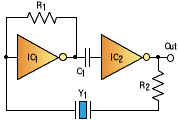What is series resonance and parallel resonance in crystals?
Series resonance crystal does not have any reactive components like capacitor. Parallel resonance crystal is used where there are reactive components involved. Series resonance crystals are resistive in nature where as parallel resonant crystals combine the phase shift properties of reactive components to determine the oscillator frequency. The following circuits explain the difference.
Parallel Resonant circuit
Series Resonant circuit
In a parallel resonant circuit, load capacitance is a critical specification.Load capacitance is the capacitance which is seen across the terminals of crystal. When we use this crystal in the application, this load capacitance must match the load capacitance requirements of the device to which crystal is connected.
A same crystal can act as series as well as parallel resonant. When used in an application, the first resonance at which crystal oscillates is the series resonance and later when reactive component like capacitor is added it oscillates at different frequency which is called parallel resonance. So, from this point if i want to use a parallel resonant crystal and we use a series resonant crystal my crystal operates at a higher frequency than desired. In turn, if a parallel resonant crystal is used in place of series resonant requirement, the parallel resonant crystal operates at a lower frequency than specified.
What is the bandwidth of crystal?
The difference between series resonant frequency and parallel resonant frequency is called the bandwidth of the crystal. Lower the bandwidth higher the stability of the crystal. As per the quality factor definition, (Centre Frequency/bandwidth), lower the bandwidth higher the quality of the crystal. So, for your application choose a crystal by checking at the quality factor curve.
What is the crystal equivalent circuit?
In the above circuit,
Co = Holder capacitance (capacitance contributed by leads extending outside the crystal)
L1 = Motional inductance
C1 = Motional Capacitance
R1 = Series resistance
The common term used in crystal specification is hermetically sealed package. What does that mean?
Hermetically sealed meant air tight enclosure with only provision for external connectivity. In our crystals case, the electrodes are extended out.
What is the difference between AT cut and AT strip crystals?
AT cut is the cylindrical version of the crystal and AT cut is the stripped version of cylindrical crystals for miniature crystals.
What constraints can affect the crystal performance?
- Assume that we connected a crystal in our application, the drive provided to the crystal should not exceed the specifications of crystal. If drive provided exceeds the rating, the crystal life time gets reduced.
- Temperature at which the crystal is operated
- Improper load capacitance can vary the crystal frequency from the desired value
What are the fundamental and overtone specification of a crystal?
Fundamental frequency is specified for lower frequency crystals (around 8 MHz, 24 MHz, etc) where as overtone is odd multiple of fundamental frequency. Overtone crystals are not preferred for micro-controller applications.







1 Comments
What you published was very reasonable. However, think about this, suppose you added
ReplyDeletea little content? I ain't saying your information is not solid, but what if you added something to maybe grab
people's attention? I mean "Using crystals in embedded applications - Part 5" is
kinda vanilla. You should look at Yahoo's front page and
note how they create news titles to get people to open the links.
You might try adding a video or a pic or two to grab people
interested about what you've written. Just my opinion, it could
bring your posts a little bit more interesting.